Today we will be discussing the popular backyard birds of Wisconsin! Wisconsin birdwatchers, you are lucky folks. There is a large number of diverse species to observe just waiting for you—but you need to know how to tempt them, when to look for them, and where to look for them.
Today we’ll help you to do just that. We’ll talk about birds that you can lure to your backyard, popular foods to tempt the little angels, and we’ll even provide some hotspots for those of you who don’t live in Wisconsin or for locals who simply feel like taking a little vacation in places with some amazing living scenery.
Let’s talk about the glorious birds of Wisconsin!
3 Categories – 440 Birds
Wisconsin is home to an impressive amount of avian wonders and while we wish we had the space to document them all the best way we can make the most of this article is to give you a sampling and divide them up by seasons so that you know when to look for them. We are dividing them up as follows:
- Year-round Resident birds
- Birds of Spring, Summer, and Early Fall
- Fall and Winter Birds
Towards the end of the article we’ll advise you based on the data we’ve collected how to load your birdfeeder to maximize your chances of luring the most diverse bird types. We can’t promise that they will come but we can definitely boost your chances. Without further ado, let’s give you a taste of the ornithological delights out there waiting to visit your backyard!
Wisconsin’s Year-round Resident Birds
Wisconsin is a beautiful state and an avid birdwatcher has a chance to see some real beauties if they live or even just visit here. A number of birds have made this state their home year-round and because of this you are almost sure to spot a beautiful bird when you least expect it. Here are 5 examples of year ‘round resident-birds that you might get to see:
- American Robin
- European Starling
- Mourning Dove
- Dark Eyed Junco
- Song Sparrow
American Robin – Turdus migratorius
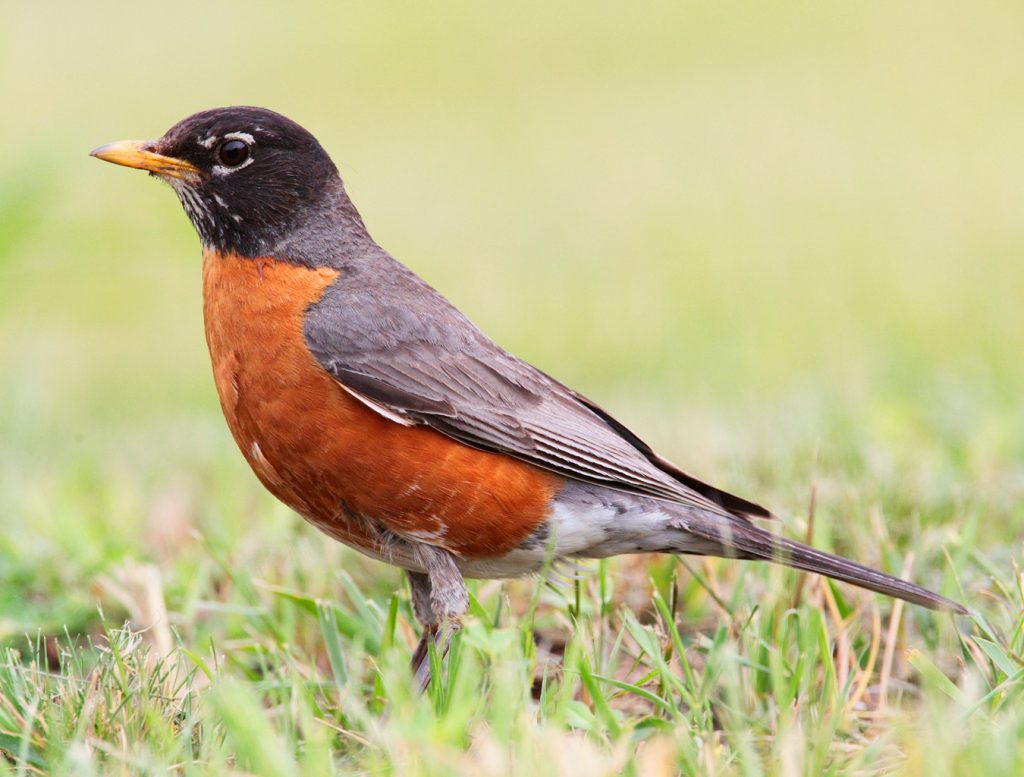
Coloration and Markings: The Wisconsin state bird is a looker and easy to recognize after you see it a single time. American Robins are gray and brown on top (sometimes they look black!) with distinctive orange breast and underbelly. They have medium sized tails and facially you’ll see a dark brown or black head with small white splotches framing the eyes next to a small, slightly curved yellow bill.
Size: These birds measure in 7.9 – 11 inches in length and they have a wingspan of 12.2 to 15.8 inches.
Habitat: Robins get around enough that it’s almost like they know that they are the state bird! Woodlands, shrubs, snow… you name it. They Love parks and gardens and if you are a golfer you’re liable to see them on the course as well! American Robins are all over Wisconsin, you’ve just got to look for them.
Diet: Robins are picky. You might lure them with Sunflower seeds but a better combination is going to be chopped apples and mealworms in your feeder.
European Starling – Sturnus vulgaris
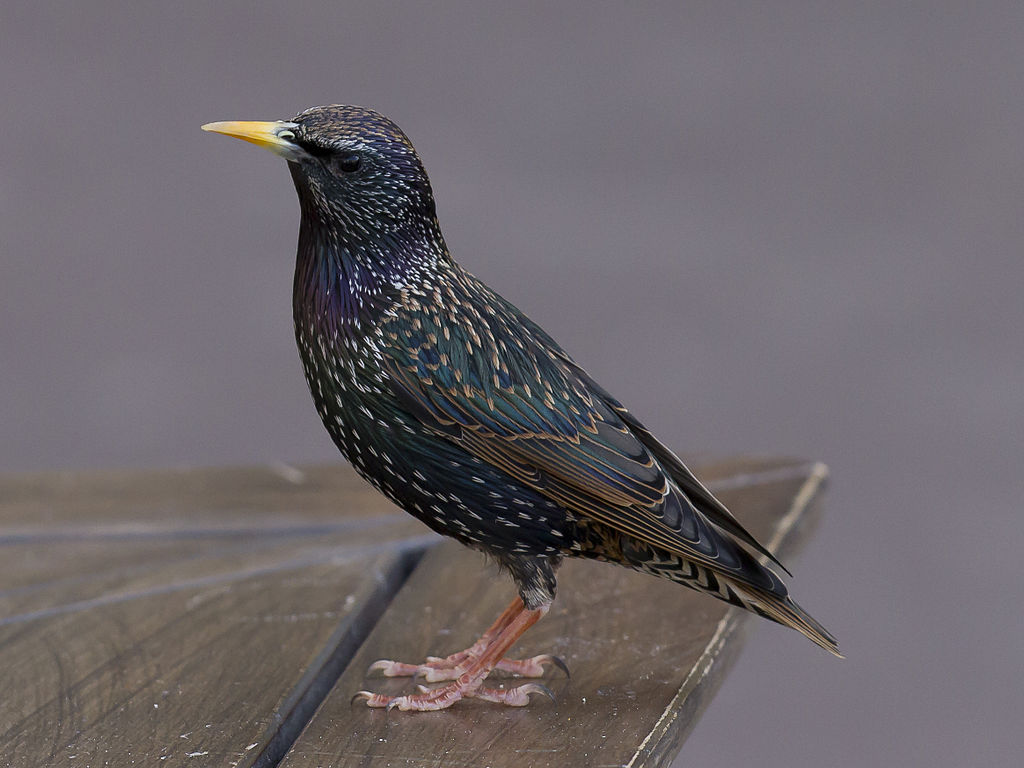
Coloration and Markings: European Starlings will vary in color based on when you see them. In the warm months they are a shiny purple-green up close (though they look black from a distance). In the winter, European Starlings look brown with white spots in their plumage. These birds have short tails and facially you’ll notice a long, straight yellow bill.
Size: About the same size as a Robin, these birds measure 7.9 – 9.1 inches from tip to tail
Habitat: These birds like painting the town red and you’ll see them on sidewalks, lawns, gardens… you name it. They often pal around with Grackles and Blackbirds and they tend to travel in groups so if you get one visiting your feeder then you can expect more to come.
Diet: European Starlings are easy to please. Load up a feeder with Suet and they will sit there and munch happily until it is gone.
Mourning Dove – Zenaida macroura
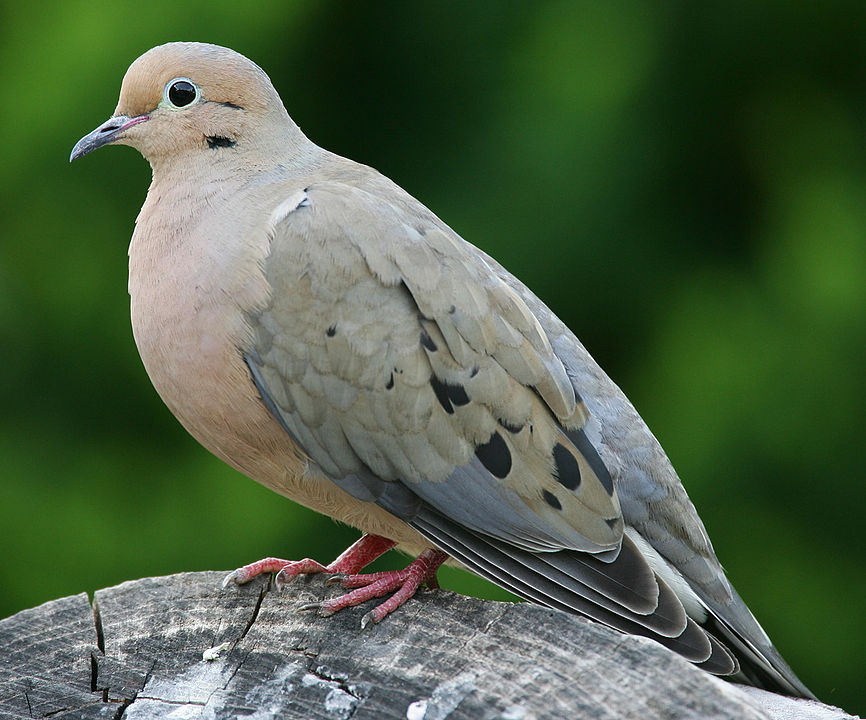
Coloration and Markings: Mourning Doves are plump and have grey and tan wings and body with the exception of their breast and underbelly, which are white with flecks of tan. The middle of the wing has distinct black spots which you will notice as well. They have long tails and facially they have tan heads with a light white crown and a thin white outline around the eyes. This is capped off with a short, sharp black bill.
Size: These Robin-sized Doves measure in at 9.1 – 13.4 inches in length and they have a wingspan of around 17.7 inches.
Habitat: Mourning Doves don’t go deep into the woods but they do hang out at the edges. They also like fields and you might see them occasionally on telephone wires. They will happily visit your feeder once they know it’s there.
Diet: You can lure in Mounring Doves with Sunflower seeds, Safflower Seeds, and Thistle seeds. Suet is especially good when winter is coming as it will give them extra energy.
Dark Eyed Junco – Junco hyemalis

Coloration and Markings: The colorations on this bird can vary from region to region, however, the Dark Eyed Junco is typically dark gray or brown on the upper body and a mix of gray (or brown) and white on the belly. One giveaway is the long white tail, which you’ll see flashes of when this bird takes flight. Facially, this bird has a rounded head and a short, sharp pink bill.
Size: Around the size of a Sparrow, this bird measures 5.5 – 6.3 inches in length and has a wingspan of 7.1 to 9.8 inches.
Habitat: In the warm months these birds enjoy coniferous forests though in winter they prefer to visit backyards and parks. You can see them at anytime but especially when it starts to get cold.
Diet: Dark-eyed Juncos love to eat cracked corn, shelled Sunflower seeds, and White Proso Millet.
Song Sparrow – Melospiza melodia
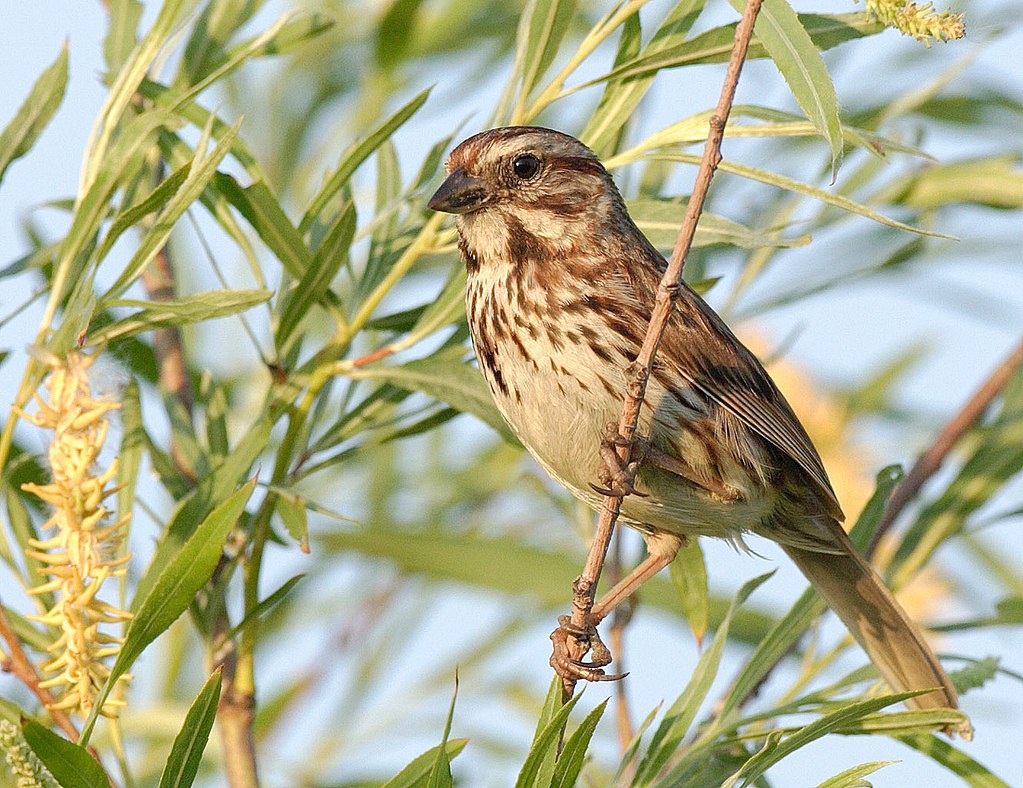
Coloration and Markings: This beautiful bird has brown streaks all over its body, with the tips of the wings showing gray and the underbelly and breast displaying a mix of both gray and brown streaks. They also have long, very animated tails. Facially, this bird has a short, sharp gray bill and a gray face with brown stripes, brown cap, and a white, curved stripe underneath the beak.
Size: Song Sparrows measure in at about 4.7 – 6.7 inches in length and they have a wingspan of 7.1 to 9.4 inches.
Habitat: These birds like fields and they are also attracted to water, such as desert washes or marshes. They are avid fans of feeders and easy to tempt, but don’t be surprised if they make a nest in one of your trees. These birds like to nest in residential areas.
Diet: White Proso Millet, Sunflower Seeds, and Corn will get the Song Sparrows attention. Give it a try and see if one comes, you might be pleasantly surprised!
Wisconsin’s Birds of Spring, Summer, and Early Fall
Wisconsin has a large and diverse avian population and a large number of them are active for most of the year. We’ve compiled a list of 5 beautiful birds that are active in this state for 3 out of 4 seasons so that you can keep an eye out for them and potentially lure them in. While we cannot promise they’ll come we can definitely help to boost your chances some tips we’ve collected just for you. So if it’s warm outside be sure to keep an eye on your garden and prepare your feeder for Wisconsin’s birds of Spring, Summer, and early Fall:
- Barn Swallow
- Baltimore Oriole
- Red-eyed Vireo
- Ruby-throated Hummingbird
- Gray Catbird
Barn Swallow – Hirundo rustica
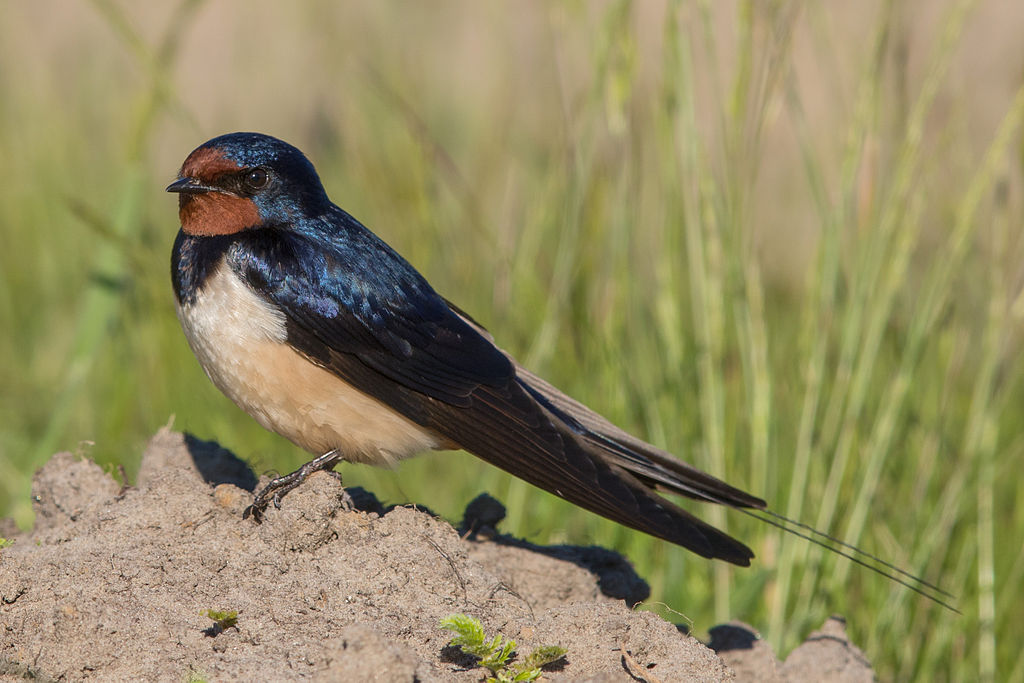
Coloration and Markings: Barn Swallows are nothing short of stunning. They have deep blue upper bodies, with lines coming from the blue on their backs onto their chest, as if they are wearing a cape. Their breast and underbelly are a contrasting orange-cinnamon color. Facially, you get a mix, with the blue on top and the orange on the bottom, extending to just slightly above the diminutive black bill. Across the eyes the Barn Swallow has a black mask as well. It’s a very distinctive bird!
Size: The Barn Swallow is 5.9 – 7.5 inches in length and has a wingspan of approximately 11.4 to 12.6 inches.
Habitat: Marshes, meadows, or as the name implies, even nesting in structures… the Barn Swallow is highly adaptable and ranges just about everywhere. They’ll visit your feeder but there is a trick to it.
Diet: These birds are picky eaters! You can’t tempt them with standards such as Suet or Black Oil Sunflower but ground up oyster shells or eggshells in the feeder might just get their attention.
Baltimore Oriole – Icterus galbula
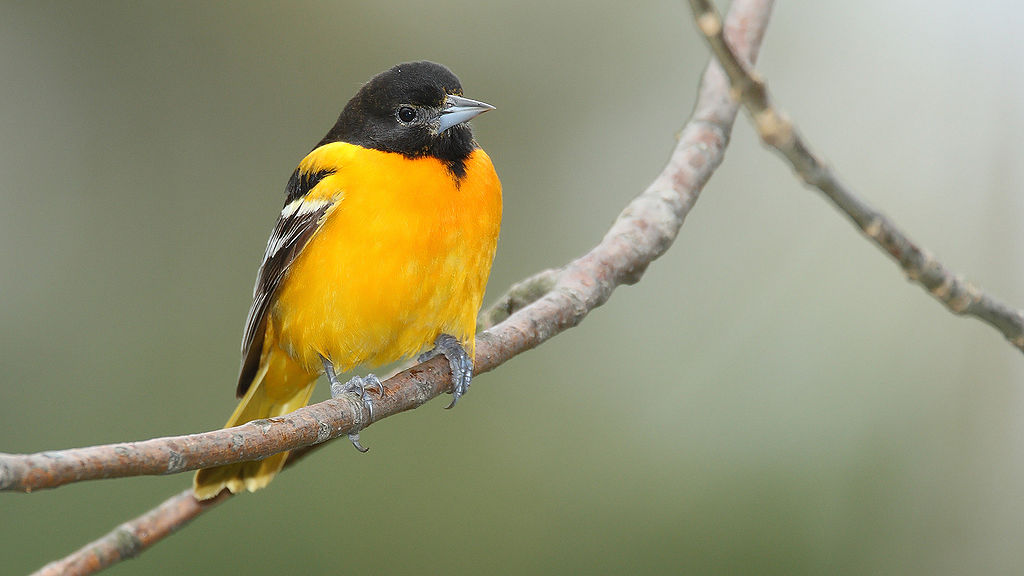
Coloration and Markings: Adult male Baltimore Orioles are quite striking, with black wings bearing white shoulder bars and a bright orange breast and underbelly (some orange extends to the wings as well). Facially, they have black heads and gray bills. The females and juveniles, by contrast, have more of a yellow-orange underbelly and breast and the wings and head are gray. The white shoulder bars are present on males, females, and juveniles.
Size: These birds are 6.7 – 7.5 inches from tip to tail and have a wingspan of 9.1 to 11.8 inches.
Habitat: These birds eschew the deep forest for the edge, preferring the open areas that these environs provide. You can also find them in parks and backyards but you’ll have to look up a bit as they prefer to be high off of the ground.
Diet: You can lure Baltimore Orioles by hanging orange-halves outside. They love fruit! Sugar water works as well.
Red-eyed Vireo – Vireo olivaceus
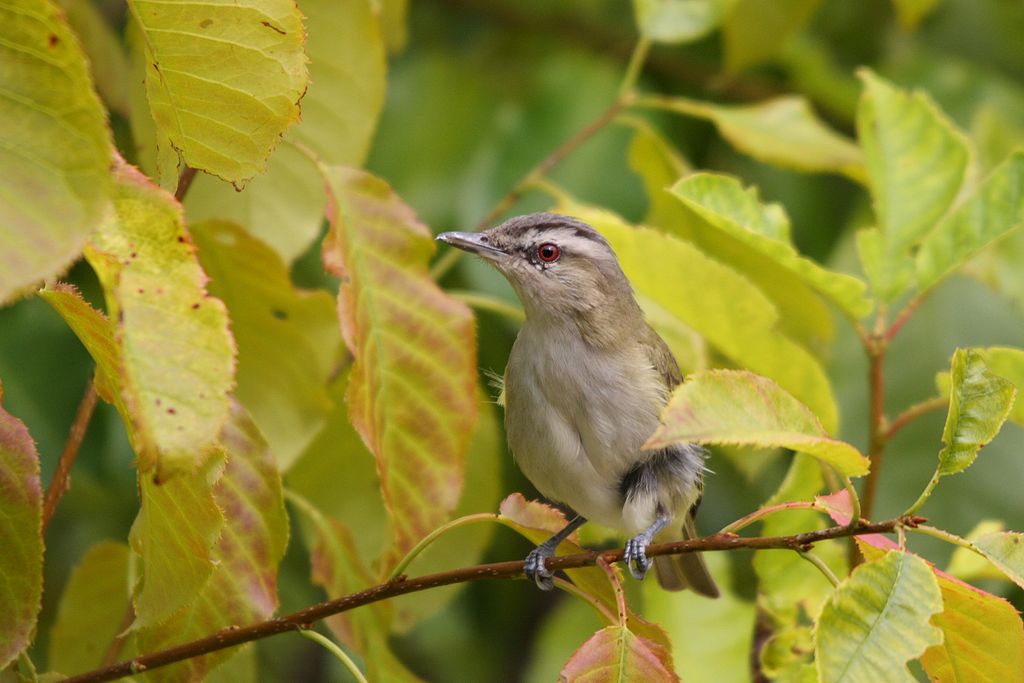
Coloration and Markings: Red-eyed Vireos are a delicate olive to emerald green on their wings and necks with white breast and underbelly. They have short tails and facially They have white chins, olive green cheeks with an olive stripe crossing the eye, topped off with a gray crown. Their beaks are black and grey, tiny, and slightly hooked.
Size: These are little guys, measuring in at 4.7 – 5.1 inches with wingspans approximately 9.1 to 9.8 inches from wingtip to wingtip.
Habitat: These birds love deciduous forests and large-leafed trees, such as maple, so look for them in the woods on in parks if you are out hiking. They can be tempted to visit your backyard and if you happen to have trees then it greatly increases your chances of waking up with a Red-eyed Vireo in the yard.
Diet: Red-eyed Vireos are fond of White Proso Millet, Sunflower Seeds, Corn, and Suet.
Ruby-throated Hummingbird – Archilochus colubris
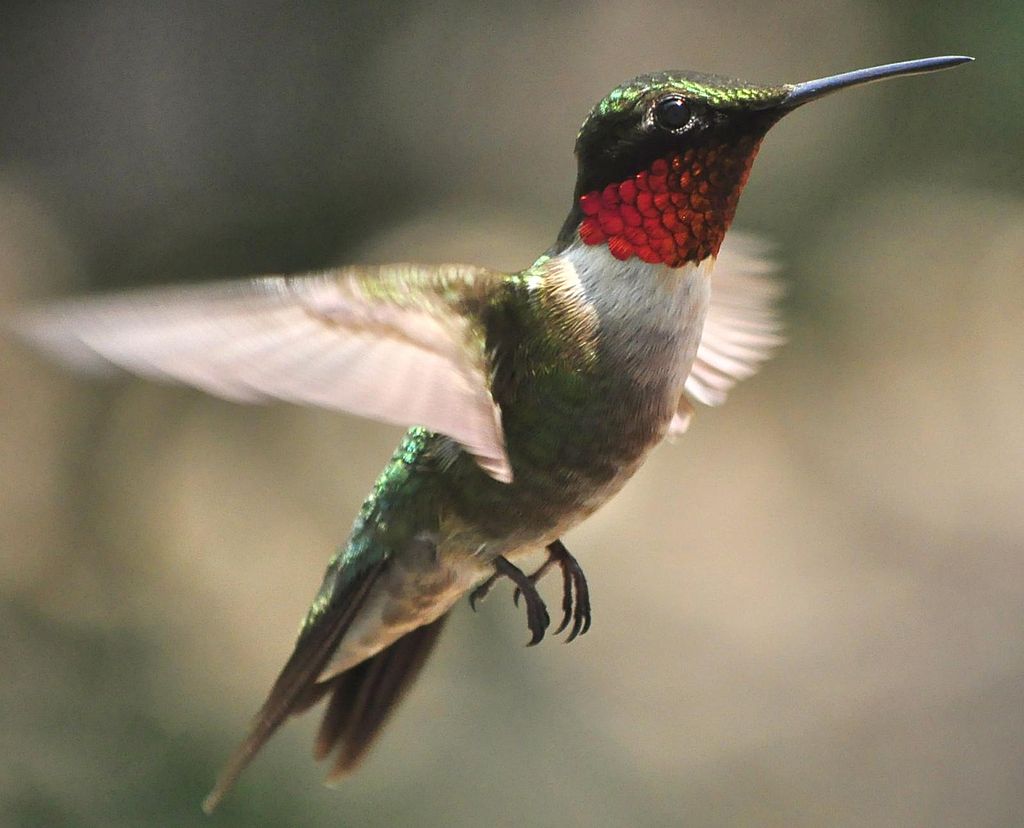
Coloration and Markings: These stunning little creatures are emerald green or sometimes green and gold on their backs and the tops of their heads. They have a band of white just under the neck that becomes grey and white as it moves down the breast to the underbelly. They also have very tiny tails and facially the throat to the chin is a brilliant ruby red terminating at beak-level, with a black dtripe crossing the eye like a mask. Their bills are long and thin for efficient nectar collection.
Size: These little angels measure 2.8 -3.5 inches in length and wingspans of 3.1 to 4.3 inches.
Habitat: These birds love forest edges, meadows, parks, and gardens.
Diet: You can tempt them with sugar water mixed at a ratio of ¼ cup of sugar to 1 cup of water. If you have a garden with flowers, however, they’re happy with those as well. The sugar water just hedges your bets!
Gray Catbird – Dumetella carolinensis

Coloration and Markings: Gray Catbirds are almost solid gray, with a few exceptions. Underneath their long tails you’ll see black from the tip of the tail up to the wing, where there is a rich orange-brown coloration. Facially, this bird has a gray face with a black cap and a medium black bill with a slight hook.
Size: The Gray Catbird measures at 8.3 – 9.4 inches with a wingspan of 8.7 to 11.8 inches.
Habitat: Forest edges, fields, and thickets are favorites of this bird. It is also attracted to water.
Diet: This bird is greedy for berries and other fruits. Put some berries in your feeder to lure them or if you have a garden, simply wait.
Wisconsin’s Fall and Winter Birds
In February of 1996 Wisconsin hit its record coldest at minus 55 degrees. Man shivered but Nature’s creatures said ‘eh’. Wisconsin Winter birds are tough and beautiful, like wrought iron works of art, and if you look for them you are going to see them! Here are 5 examples of Wisconsin’s Winter bird club to watch for:
- American Crow
- Northern Cardinal
- Sedge Wren
- Red Bellied Woodpecker
- Black-capped Chickadee
American Crow – Corvus brachyrhynchos

Coloration and Markings: These playful, curious Corvids only have one color in their wardrobe. Black wings, black bodies, and medium sized black tails (squared or rounded at the tips). Facially, they have black heads with black beaks with a distinctive curve.
Size: Crows are big enough to get your attention, measuring in at 15.8 – 20.9 inches in length with wingspans of 33.5 to 39.4 inches.
Habitat: Crows go wherever they want. Woods, marshes, parks, and especially backyards. They are extremely intelligent and comfortable with people, so if there is a crow in your yard be careful how you deal with it. You have a chance to make a great friend or a bitter enemy who won’t forget your face.
Diet: Crows eat everything so whatever you put in the feeder is fine. If you really want to attract them, a Native American trick from the American Southwest is to make a crow silhouette out of wood or metal. Paint it black and perch it on a fence or another visible place. Other crows will see it and flock to it.
Northern Cardinal – Cardinalis cardinalis
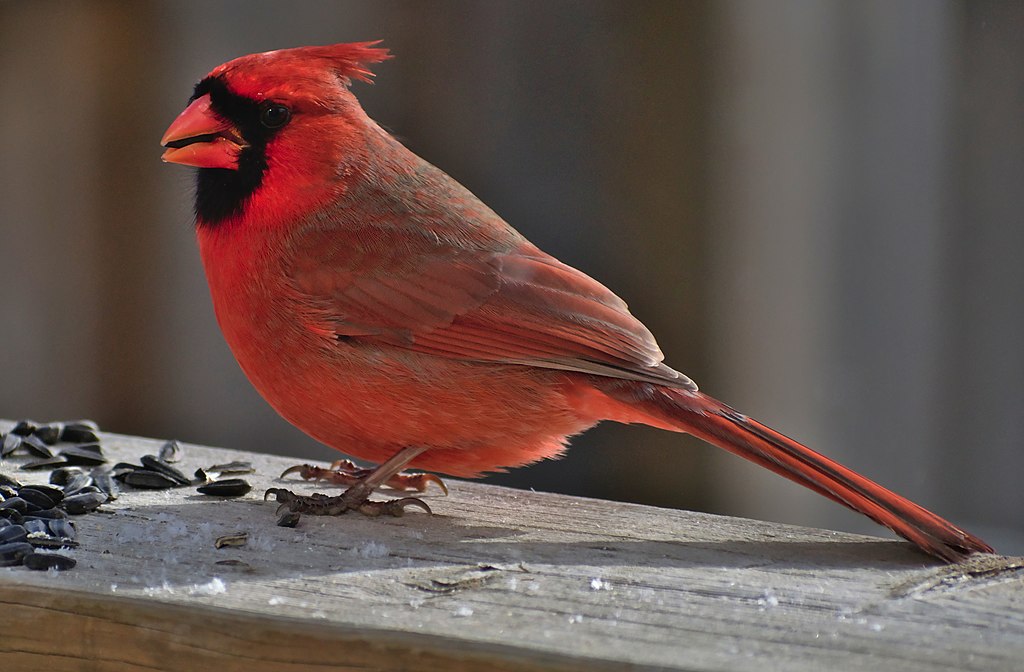
Coloration and Markings: Cardinals are breathtaking. The males are a study in red, with red bodies and long red tails. Facially, they have a red crest and a black mask which extends down below the chin. Their bills are short and sharp and colored orange-red. Females have the same mask and bill but they are brown in color.
Size: Slightly larger than a Robin, the Northern Cardinal measures in at 8.3 – 9.1 inches and has a wingspan of approximately 9.8 to 12.2 inches.
Habitat: Forest edges and parks are favorite places of Northern Cardinals. They are also very much backyard birds and they aren’t shy about visiting feeders.
Diet: Black Oil Sunflower seeds are a particular favorite of this bird, though they will eat just about anything that you leave out for them.
Sedge Wren – Cistothorus stellaris
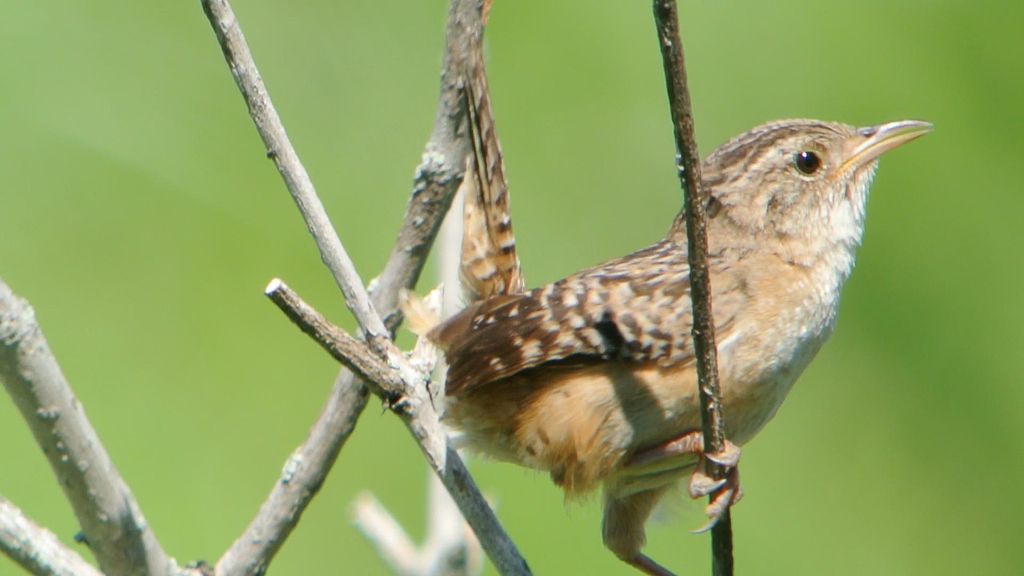
Coloration and Markings: This short-tailed Wren has a streaked back and banded wings and tail. You’ll notice the Sedge Wren likes to hold its tail up much of the time. Facially, this bird has thin streaks on it’s crown and a long, thin yellow bill.
Size: The diminutive birds measure at 3.5 – 4.7 inches in length and have a wingspan of 4.7 to 5.5 inches.
Habitat: Marsh Sedges and in the grass, these little birds are actually quite nomadic.
Diet: Peanut butter, Peanuts, and Suet can potentially lure these little guys into your garden.
Red Bellied Woodpecker – Melanerpes carolinus

Coloration and Markings: These birds are almost clownlike, with pale, white bodies with black and white striping on the back. They have white patches on their wings and facially they have rounded heads, long and thin black bills, and a red cap which extends from the bill to the back of the neck like a red wig.
Size: The Red Bellied Woodpecker measures in at approximately 9.4 inches from tip to tail. They have a wingspan of 13 to 16.5 inches.
Habitat: These birds love the woods and are especially fond of hardwood trees such as hickory and oak. They are very fond of backyards as well, so don’t be surprised if one comes to visit you to sample the feeder treats that you’ve left for them.
Diet: Suet, Black Oil Sunflower seeds, and Peanut butter are favorites of the Red Bellied Woodpecker.
Black-capped Chickadee – Poecile atricapillus
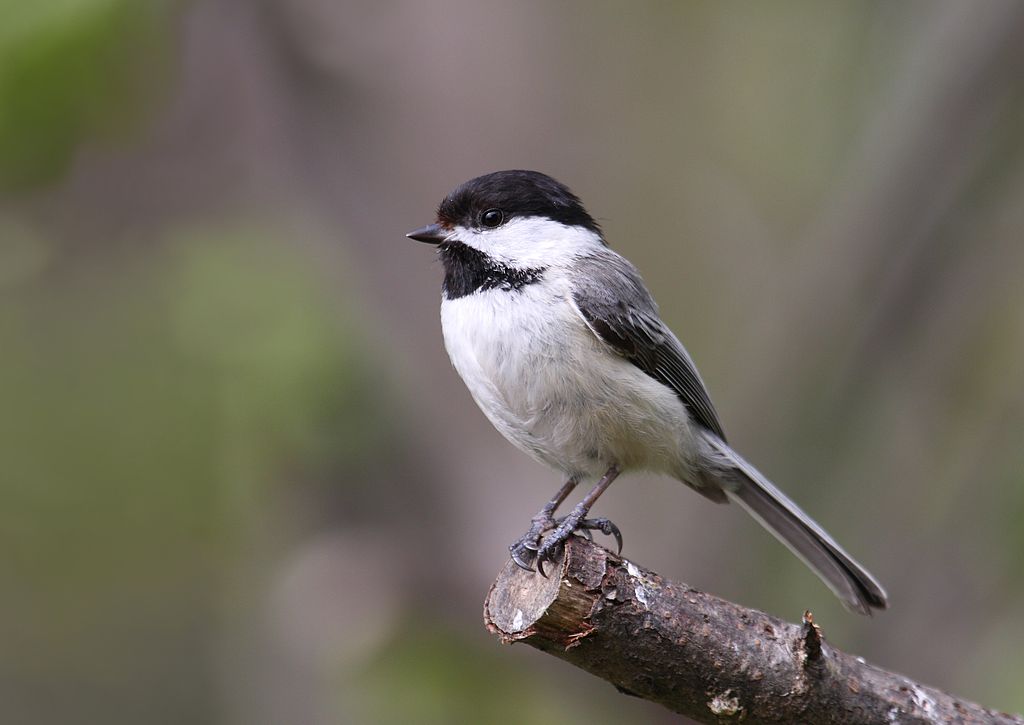
Coloration and Markings: These birds are quite distinctive, with white breast and underbelly and gray and white wings. Facially, they have black on the upper half of their heads and below their bills, with a white stripe dividing the colors curving from the bill under the eye all the way to the back of the neck. Their bills are short, black, and very triangular, like half of an ice cream cone.
Size: These birds measure in at 4.7 – 5.9 inches and have wingspans of 6.3 to 8.3 inches.
Habitat: Forests, shrubs, and marshes are popular places for this bird, but they are also fond of residential locales.
Diet: You can lure Chickadees with a mixture of Suet, Peanuts, Peanut Butter & Cornmeal, and Black Oil Sunflower seeds.
Other Backyard Birds of Wisconsin That Might Pay You a Visit
Wisconsin has many year-round birds that could pop by for a visit at any time, so we’ve compiled some data to help you recognize just who is paying you a visit. These 5 birds are no strangers to feeders so be sure to keep an eye out for them. Here are the 5 Supporting Cast birds to look for this year:
- White Breasted Nuthatch
- Common Grackle
- Blue Jay
- Downy Woodpecker
- House Sparrow
White Breasted Nuthatch – Sitta carolinensis

Coloration and Markings: Easy to recognize, these birds have a white breast and underbelly with gray-blue wings with the occasional black streak to accent them. They have short tails and facially they have long, thin bills that are blackon top and gray on the bottom and a black cap that extends from bill to the back of the neck. There is also a short, delicate black line extending from the back of the eye, slanting upwards to the tip of the cap.
Size: The largest of the Nuthatches, this bird is still tiny at 5.1 – 5.5 inches, with wingspans of 7.9 to 10.6 inches. They are roughly Sparrow-sized and sometimes a little smaller.
Habitat: They love hanging out in the edge of the woods and their favorite trees include Hickory, Oak, and Maple.
Diet: They’ll eat Suet but if you really want to get their attention, go with Black Oil Sunflower seeds and Peanuts. They love Peanuts!
Common Grackle – Quiscalus quiscula
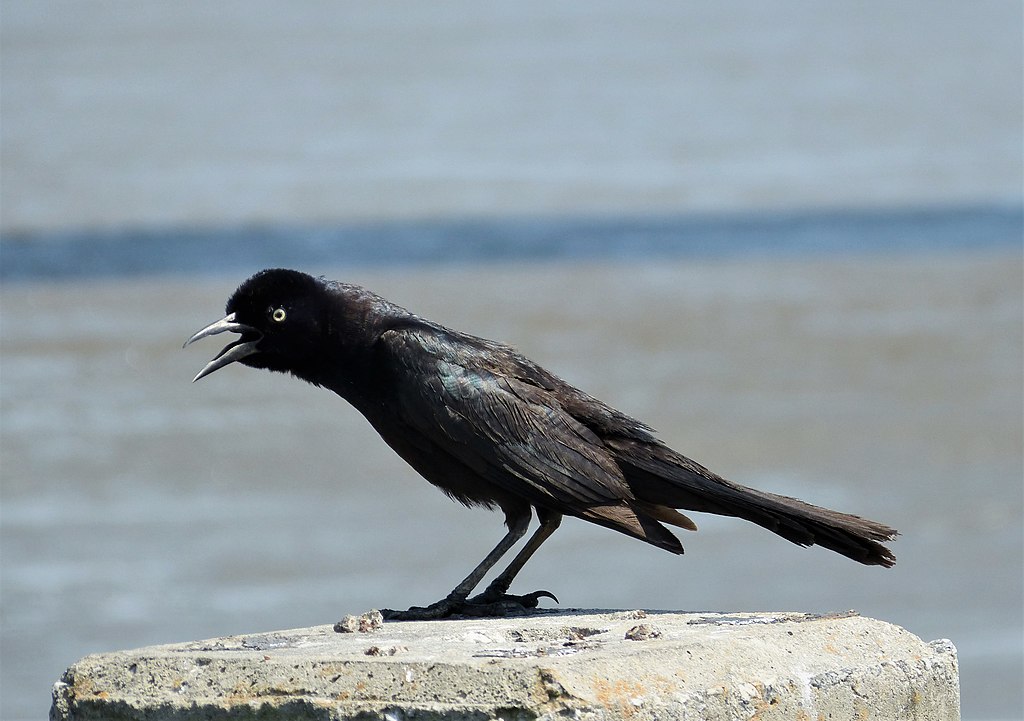
Coloration and Markings: The Common Grackle is a pretty bird, with a blue-black body and blue-purple neck and head. They also have long, rounded tails. Facially, these birds have striking golden eyes and long bills with a slight curve. Females are a little less shiny and often have brown bodies with the blue-black heads.
Size: These are big birds, measuring in at 11 to 13.4 inches in length with wingspans of 14.2 to 18.1 inches.
Habitat: Fields, parks, and your backyard… Grackles are everywhere and easy to spot.
Diet: Suet, Peanut Butter & Cornmeal, Black Oil Sunflower seeds… even just your standard variety pet store birdseed will lure Grackles to your feeder. While some consider them a nuisance, these birds can be quite entertaining to watch. Just because they are common doesn’t mean they aren’t beautiful.
Blue Jay – Cyanocitta cristata
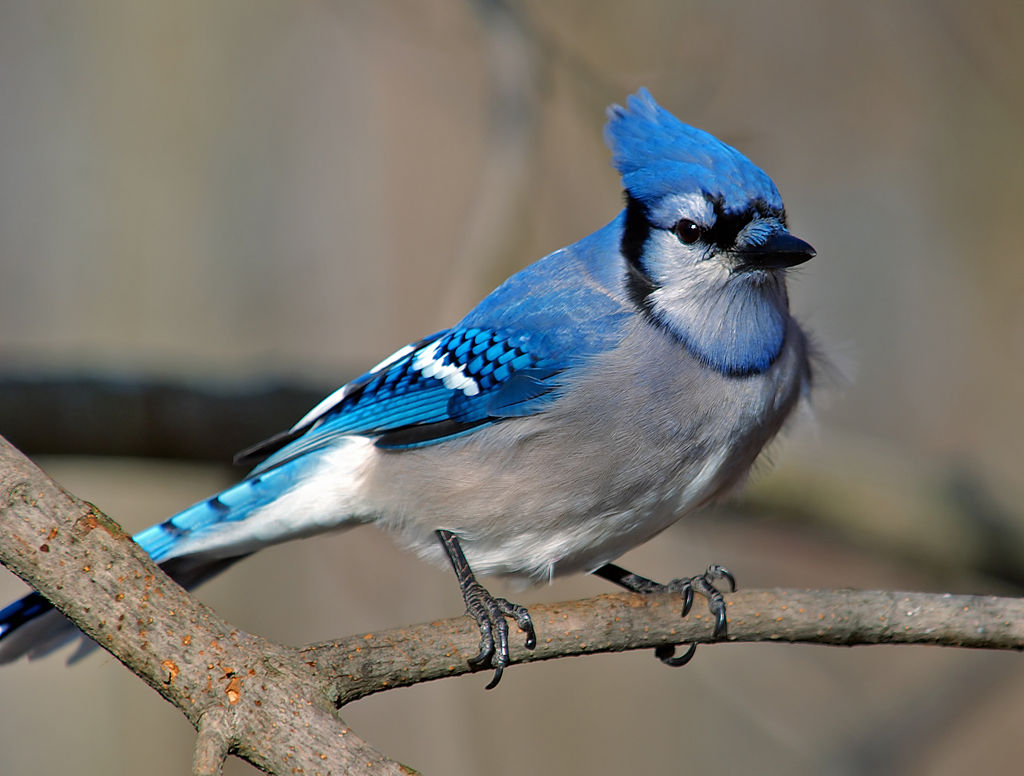
Coloration and Markings: Blue Jays are almost iconic when it comes to recognition. They have a distinctive white or light gray breast and underbelly, with blue wings showing black accents and white lines and splotches across the back. They also have short, blue tails with black stripes. Facially, they have a blue crest with a black line starting from the back of the crest and curving around the base of the neck to the other side. They also have a black ‘mask-stripe’ and medium-sized, straight black bills.
Size: Blue Jays measure in at 9.8 – 11.8 inches and have an average wingspan of 13.4 to 16.9 inches.
Habitat: These birds like the edges of forests and are especially fond of Oak trees. They find acorns a taasty snack, so if you have an oak tree in your yard then you might just have a Blue Jay soon, too.
Diet: Blue Jays love Peanuts, Sunflower Seeds, and Suet.
Downy Woodpecker – Picoides pubescens
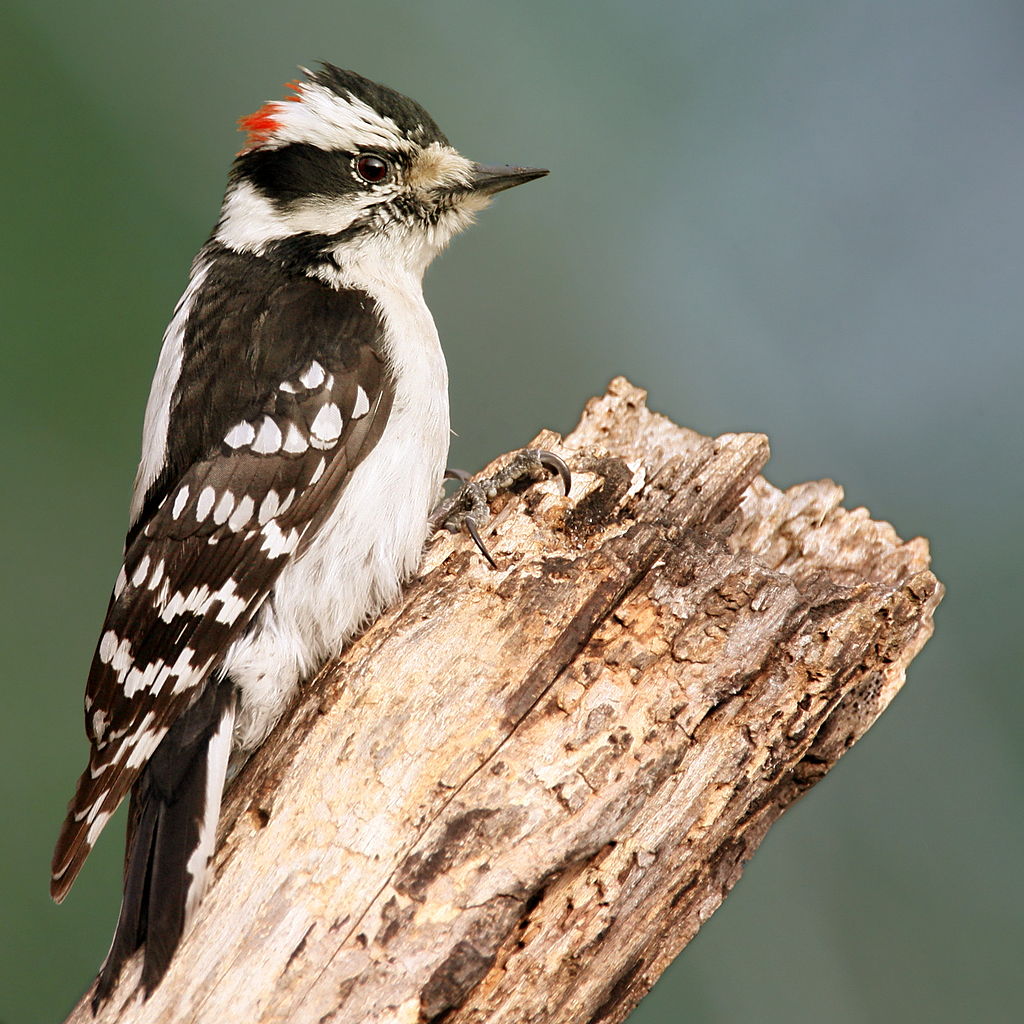
Coloration and Markings: Downy Woodpeckers have white breast and underbelly, with black wings which show checkered patterned across them. A white stripe goes across the back and these birds have solid black tails. Facially, they have white faces and a black stripe on the top of their head, across the eyes, and coming back from the bill to the base of the neck. They also have short, conical beaks and the males have a tiny red cap on the back of the head.
Size: These birds measure in at 5.5 – 6.7 inches with a wingspan of 9.8 to 11.8 inches.
Habitat: These birds are fond of woods, orchards, parks, and backyards.
Diet: Black Oil Sunflower, Peanuts, Suet, and Peanut Butter & Cornmeal are all favorites of this bird.
House Sparrow – Passer domesticus

Coloration and Markings: These birds have a grey and white breast and belly with rich, brown wings with black accents. Facially, they have white cheeks and a broad, brown stripe across the eye, curving downward to the neck, and a gray cap on the top-forward portion of the head. These birs have short, stocky black beaks with a slight but noticeable curve.
Size: House Sparrows measure in at 5.9 – 6.7 inches with wingspans of 7.5 to 9.8 inches.
Habitat: Farms or anywhere else that there are buildings. House Sparrows have lived around humans for a long time and adapted long ago to live close to us.
Diet: White Proso Millet, Sunflower Seeds, and Corn are favorites of this bird.
Wisconsin Bird Buffet
Wisconsin birds have their own preferences and a few of them can be a little picky. With that in mind we have some recommendations for loading your feeder to attract the most diverse amount of bird species economically. They come from a good source, namely the Wisconsin Society for Ornithology, so be sure to take notes! Should you wish to make a ‘Wisconsin Bird Buffet’, here are the recommendations for loading your feeder to get the best results:
- Sunflower seeds
- Cracked Corn
- Wheat and Oats
- Nyjer Thistle
- Suet
- Peanuts
- Fruit
Wisconsin Birding Hot Spots
If you feel like taking a little vacation or if you are planning on visiting Wisconsin soon, we’ve compiled a list of hotspots that you might want to consider visiting. We’ve divided them up into compass points moving clockwise so that wherever you are in Wisconsin there should be a location close to you where you can view Nature and our fine feathered friends up close and personal. If you want to see the winged celebrities of Wisconsin then the Chirparazzi recommend that you visit one or more of the following locations:
- Northern hotspot – Lewis Trough Mounds Trail – Lewis/Trough Mound Recreation Area
- Eastern hotspot – Brady’s Bluff and Riverview Trail – Perrot State Park
- Southern hotspot – Bugline Trail – Spring Green Park
- Western hotspot – Pike Lake Trail – Kettle Moraine State Forest Pike Lake Unit
- Central hotspot – Lime Kiln Trail – High Cliff State Park
Detailed descriptions of each location as well as information regarding visiting and what birds you can see at these locations may be found here: https://www.alltrails.com/us/wisconsin/birding
Conclusion
Well, that’s all we have for today. We hope that the information which we have provided will help you to make your own ‘who’s who’ checklist of Wisconsin birds and give you just the right combination to fill your feeder and lure these little wonders into your backyard. Bird watching is a rewarding hobby. It’s relaxing, exciting, and you never know just what bird is going to show up. Until next time, keep an eye out and a full feeder and let Nature do the rest!
